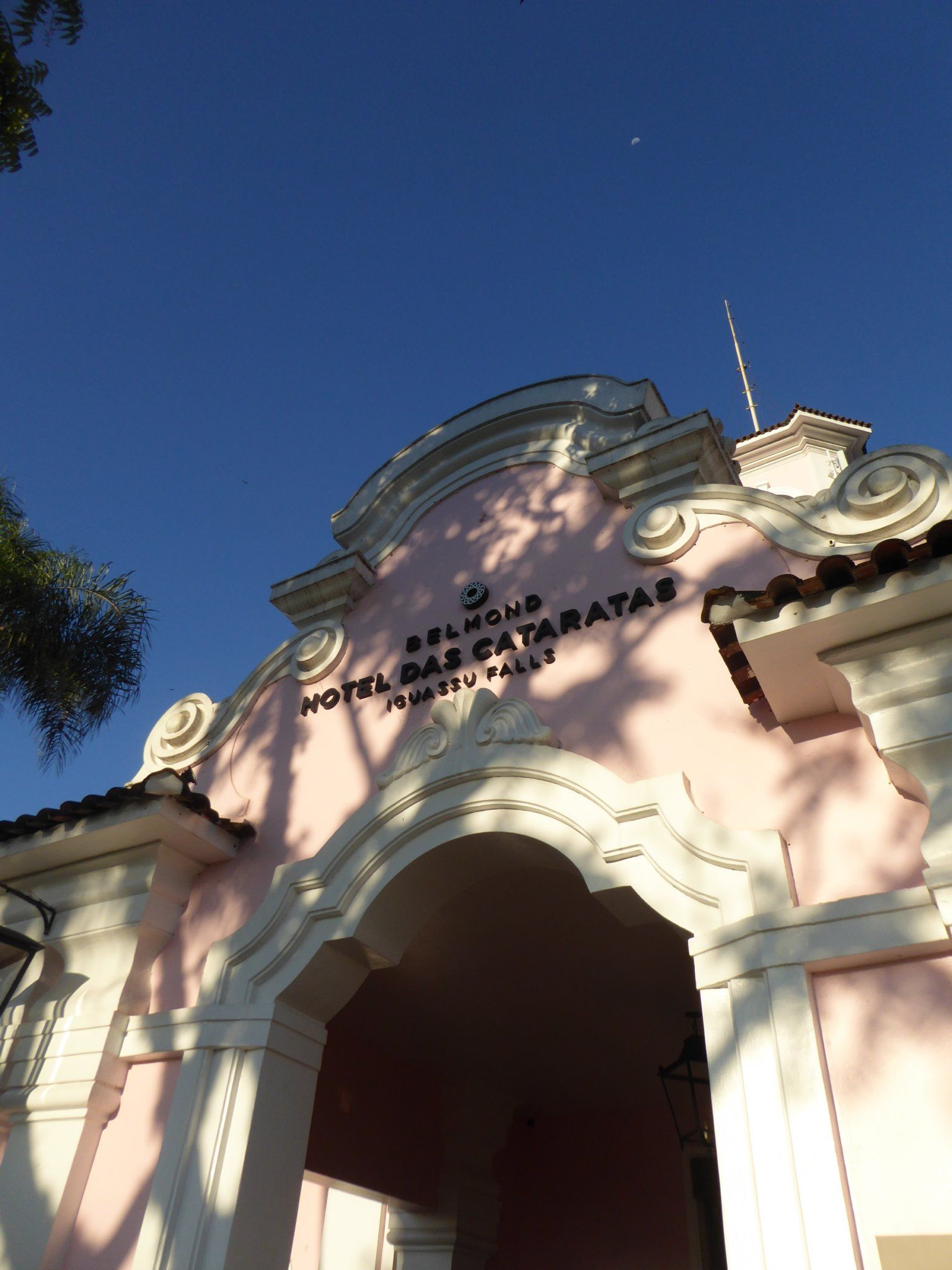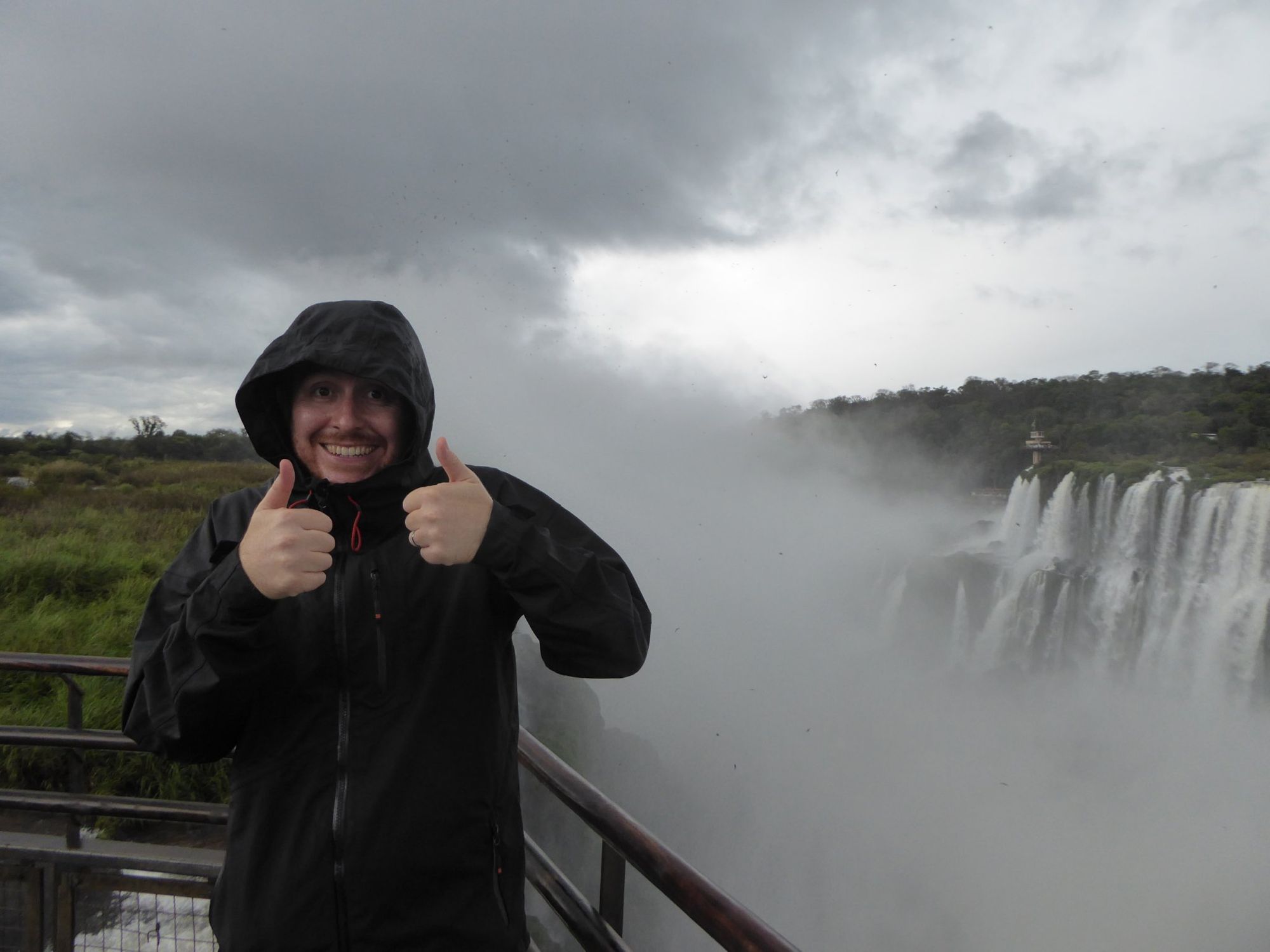Iguazu Falls: Both sides of the story

We always expected Brazil to be the most expensive part of our trip, but even so, getting by on a backpackers' budget was tricky at times.
So we were excited to arrive at our final stop in Brazil, Iguazu Falls, where we'd decided to allow ourselves a splurge on a night in a luxury hotel. Iguazu is the largest system of waterfalls in the world, surrounded on both sides of the Brazil-Argentina border by a protected national park, and strict regulations mean that there only two hotels inside the park itself, one on each side of the falls. We treated ourselves to a night at the Belmond Hotel das Cataratas, a plush pink palace designed in a Portuguese colonial style, which first opened its doors in the 1950s.

I don't normally write about hotels on my blog, but this one is worth mentioning for the very special access it gives you to Iguazu. The hotel is situated right next to the trail that runs along the Brazilian side of the falls, and hotel guests can access the trail early in the morning or in the evening, when the park is closed to the public. We arrived mid-afternoon on Monday, and by the time we wandered down to the top of the trail at 4pm there were very few other tourists around.
The first thing that hits you when you see the falls is the sheer scale. We'd already had a brief bird's eye view as our plane came into land (top tip: choose seats on the left-hand side when flying into the airport in Brazil), but it's not until you see them at ground level that you start to get a sense of just how vast the falls are. There are hundreds of individual waterfalls, and nearly 2,000 cubic metres of water cascades over the towering basalt cliffs every second.

The other thing we noticed straight away is that we weren't alone on the trail, and I'm not talking about our fellow tourists. The national park is a remnant of the Atlantic rainforest which once covered much of southern Brazil, and the forest is teeming with life. Iguazu's most famous (and cheekiest) residents are its coatis, a type of racoon with sharp claws for burrowing and a long, pointed snout. These crafty little creatures figured out a long time ago that clueless tourists are a bountiful source of easy meals, and they're incredibly brazen in their attempts to pilfer snacks from your bag. In spite of signs everywhere warning people to keep their food out of reach, the trails around the park reverberate with the sounds of shrieking tourists who've just had their bag ransacked by a gang of coatis.

The trail on the Brazilian side of the falls connects together a number of viewpoints, with each vista seemingly even more spectacular than the last. Every time we thought we'd got our heads round the size and layout of Iguazu, we'd round a corner and realise that another huge series of waterfalls had been hiding just out of view. Every now and again the sunlight would catch the clouds of spray at just the right angle, and we'd see rainbows arcing across the falls.
Eventually we came to the point where the trail forks, with one path leading back up towards the road and the other continuing onto a metal walkway perched above the water. This walkway takes you incredibly close to perhaps the most spectacular of all the falls, known as La Garganta del Diablo - 'The Devil's Throat.' At this point roiling torrents of water thunder into a U-shaped canyon, creating a huge cloud of spray that never clears, rising skywards like some infernal smoke emanating from the depths of the earth. The roar of the falls here was intense, and we were soaked in a fine mist as we walked out across the metal bridge into the edge of the cloud.

As we wandered back along the road to our hotel we spotted a troop of monkeys moving through the undergrowth, and a lone toucan perched at the top of a tall tree. By the time we arrived back at the beginning of the trail it was practically deserted, and we felt incredibly lucky to experience the falls in this way; even more so the following morning, when coachload after coachload of elderly Uruguayan tour groups started pitching up, singing songs and waving Uruguayan flags.

In order to fully appreciate the majesty of Iguazu you need to visit both sides of the falls, so on Tuesday we took a taxi across the border to the town of Puerto Iguazú and the second country on our itinerary, Argentina. We weren't staying in the national park this time, but we still had a pretty nice hotel just next to the Paraná river, with great views of Paraguay on the opposite bank. In fact we were so close that my phone welcomed me to the country, and put my clock back an hour to Paraguayan time.
The trail on the Brazilian side of the border gives you the widescreen overview of the falls, while the Argentinian side gets you up close. The park seemed extremely busy when we arrived in the morning, but there is an extensive network of trails cutting through the jungle, most of which were mercifully free of coach tour groups. We tackled the lower trail first, which runs along the bottom of several of the falls. We arrived at a viewpoint where a group of monkeys were swinging around in the trees overhead, keeping an eye out for tourists who could be easily parted from their snacks. One of them was engaged in a long and fruitless attempt to get into a rubbish bin, unable to hold the bin open and reach into it at the same time without the lid crashing down on his head.

After stopping off at a cafe for a couple of empanadas we continued on to the upper trail, which skirts over the top of several of the waterfalls, with spectacular views of the mist rising above the jungle below. As storm clouds began to gather overhead we stopped to marvel at the view, like something out of Arthur Conan Doyle's 'The Lost World'.

The day had started off blazing hot and sunny, but the sky rapidly began to darken and finally the storm broke, with great forks of lightning dancing across the charcoal clouds and thunderclaps briefly drowning out the roar of the falls. We pushed on to the final and most exposed of all the trails, a long metal walkway that straddles the Iguazu river and takes you all the way to the edge of the Devil's Throat.

By the time we reached the precipice the rain was coming down in sheets, my shoes squelching with water and my supposedly waterproof jacket funnelling rain down my chest. Clouds of great dusky swifts danced above the cliffs and the wind buffeted the giant Argentinian flag overhead as we peered down into the morass of white water. It was an almost incomprehensible sight, which no photo or video could ever hope to capture, and which no group of Uruguayan pensioners, no matter how rowdy, could ever spoil.

